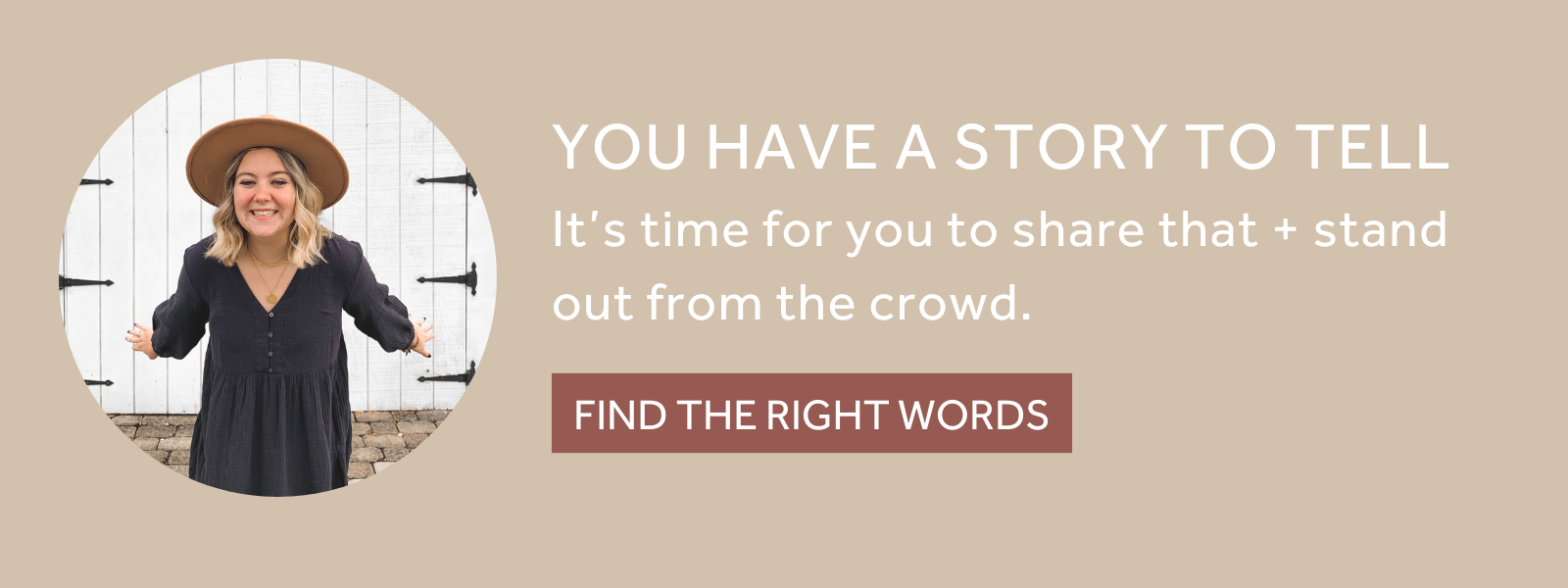10 Signs You Need to Update Your Website Copy
Woo hoo – your absolute DREAM customer has landed on your site! This is the moment you’ve been working toward. It’s your chance to transform them from a stranger to a loyal customer. Your website and words should convince them that you’re the solution they’ve been searching for.
But is your website copy really doing its job?
Well, I should say jobs. We ask the words on our website to do a lot.
They need to be persuasive, powerful, memorable, and meaningful. The words on each page need to be enjoyable, clear, compelling, captivating, and most importantly, they need to prove that we’re the best of the best.
And the need to do those jobs (and more) 24 hours a day, every day, all year long.
But how can you tell if they’re working as hard as they need to? … Or is your website copy sleeping on the job?
There are some glaring signs, like not getting leads or having insanely high bounce rates, but many indicators can require more digging. In this post, you’ll discover 10 signs that it’s time to take a step back and re-examine your website copy.
Here are 10 signs your website copy is underperforming
1. You’re attracting the wrong clients
Can’t remember the last time you were so excited to work on a project that you didn’t need coffee? Do you feel like you’re always stuck with the tire-kickers, hagglers, or brands you just aren’t excited to work with?
Attracting people who aren’t your dream clients are a sure sign that you’re failing to attract your dream customers.
Which means (you guessed it!) your website isn’t doing its job. It might be your graphics, copy, branding, products, services, pricing, online experience, or any combination of those that aren’t up to par.
Whatever piece(s) of your website it may be, it’s probably because you haven’t properly identified who you want to work with. So it’s up to you to pull on your Sherlock Holmes cap and figure out what it is that’s holding your website back.
2. You’re not attracting clients at all
Been a while since a potential client got in touch with you? Are there virtual cobwebs inside your website’s contact form?
That’s a bad sign for your website and your brand! Things have definitely gone awry.
A good website attracts consistent feedback and inquiries. A great website has inquiries and love letters pouring in daily.
So if neither of these descriptions feels like your situation, your contact page likely needs a little love.
Your first stop? Double-check that your contact form is actually working. Then, if it is (phew!), it’s time to devise a plan to optimize it and drive traffic to its digital doorstep.
3. Your site speed is sluggish.
If your site takes longer to load than your AOL dial-up internet from the 90s, it’s time to bring your site up to speed.
The bad news is your slow site is doing more than just frustrating your visitors. It’s likely cramping your conversion style too.
Research has shown that anything longer than two seconds doubles your bounce rate and sends your dream customers packing. The first 5 seconds of page-load time are crucial to your conversion rate. With each extra second, your conversion rate drops by 4.42 percent (according to HubSpot).
Speaking of which …
4. Your bounce rate is bouncing sky-high
Your bounce rate is a website data point that reveals what a visitor does after arriving on your site. Are they exploring your site? Or is your website a virtual revolving door, sending them quickly in and out?
If a website visitor fails to click through to another page on your site and, instead, clicks’ back’ or closes their browser, they’ve just bounced.
A bounce isn’t a good thing for you or your website. And a bounce rate that’s bouncing higher than a bouncy ball is a bad sign.
For example, if a user arrives on your home page, you want them to click through to your about page, services page, blog page, ANY page!
After all, you want all those dream customers to stay on your website and make themselves at home. Once they get cozy, you can introduce yourself, but right now, they’re leaving before you get to say hello!
So, what’s a bad bounce rate?
Good question. Well, as a general rule, anything above 50% requires your immediate attention. If one out of two (or more than that!) of your site visitors pop into your site just to immediately jump back out, your website is underperforming.
5. Your sales are slow and low.
Your website should be making sales. It’s that simple.
So if your business isn’t reaching your sales goals, then your website is underperforming.
The good news? It can be fixed!
First, you need to identify what’s blocking your sales flow. Whether it’s your website copy, online journey, or branding, find the squeaky wheel and then realign it with your target market and vision.
If you think your sales copy isn’t hitting home, try out these 70 persuasive words on your website!
6. Your SEO sucks.
Shouting insight and advice from the third, fourth, or even higher search results page? Feeling like you’ll never be seen, heard, or make it onto the first page of Google’s search results?
Well, time for some tough love. You can’t expect to always be on the first page of Google for every single keyword you’re targeting.
But, that being said, there should be at least one keyword that you rank highly for on Google. So yes, you should be on page one or close to it for some search terms!
Search results are responsible for up to 90% of web traffic, so if your website hasn’t wiggled onto the top few pages of Google search results, it’s sleeping on the job.
7. Your traffic is only coming from one major highway
Woohoo! You’ve got traffic coming in by the boatload from one source. one of your strategies for driving web traffic is thriving!
And that’s awesome. Let’s take a minute to celebrate that win.
And then, it’s time to get back to work.
Regardless of where your website visitors are coming from, your traffic sources’ diversity is crucial for long-term web traffic security. So while you may be a shining star on Pinterest and attracting tons of visitors to your site, make sure you include other sources in your marketing plan.
If you’re getting an unusually high percentage of your visitors from one specific platform, an algorithm change or an unexpected downtime could have serious implications.
With a greater diversity of traffic sources, you’ll be sitting pretty, ready to weather any storm that comes your way.
8. You don’t have repeat visitors.
Getting visitors to come back regularly rarely just happens on its own. It takes a plan and a website that’s putting in the work.
Take a look at your own analytics, and compare your ‘users’ and your ‘sessions.’ How do they look? Probably like whole numbers that don’t mean much to you right now.
Here’s what you need to know. Your ‘users’ are unique individual visitors to your website. And your ‘sessions’ are the number of times your website has been visited.
Ideally, you want more sessions than users, as this means you’ve got people coming back to your website and revisiting your content.
Getting repeat visitors is so important for your brand. Repeat visitors show that your website is interesting, engaging, and sticking with the people who find it.
And… potential customers need to interact with your brand several times before they feel ready to invest.
9. Your services, products, or offerings aren’t being viewed.
While you’re exploring your website analytics, take a look at your most visited pages. These will typically be your home page, your about page, and any content you’re currently promoting.
But within this group, you also want to see your top offerings.
For me, that’s my overall services page, brand messaging, and copywriting. So when people visit my site, it’s my job to make sure they find ’em and check ’em out.
After all, if my visitors aren’t checking out my stuff and getting to know me, how will I ever work with my dream clients? Spoiler alert: I won’t.
10. You aren’t proud to show off your site.
Do you hesitate to share your website? Would you rather people look at your curated Instagram feed than your website home page?
Hmm. Not a good sign.
I believe you should love your website with your whole heart. Sure, a website is always changing, growing, and updating. So it’s natural to tweak, change, and revise it frequently (and honestly, I recommend doing so!)
But your website should be one of your proudest accomplishments – whether you built it yourself or relied on a team of experts to get you there.
You should want to send everyone pictures and links to your site. You should do a little happy dance every time you see your home page!
Your website should represent who you are, your vision for your brand, and what you do. Your website should have a personality aligned with your brand and your dream customers; It should be stunning and strategic; it should tell your story clearly.
Again, I know we ask a lot of our websites. But you deserve it. Your business deserves it.
You deserve a website you can’t wait to share with the world … And one that draws in the conversions, sales, and rave reviews that you deserve.
When you’re ready for a new website, keep in mind: copy informs design.
It’s easy to get excited and jump ahead to the fun parts (like photos and illustrations). But a website copywriter is the person who lays the foundation for the sales strategy and user flow.
So How Often Should You Update Your Website Copy?
This is a tough one, and there is no standard rule or answer written in stone.
Updating website copy is a task that can easily get swept under the rug – especially if your website is getting decent traffic and leads.
I mean, why fix something that isn’t broken, right?
But in addition to the 10 signs listed above, you need to consider that search engine algorithms are constantly being refined. As a result, the way they interpret website copy changes.
Additionally, web design trends tend to dictate how much – or how little – copy is ideal for a webpage.
There are many reasons to update your copy, even if you don’t see these warning signs. Even if everything seems peachy on your website, keeping your content and copy up to date is one way to keep those warning signs and glaring red flags away.





I’m a wife, mom, and storyteller who has spent more than five years helping 100+ brands with their marketing. I’m here to tell stories with heart, and empower other women to boldly share theirs.